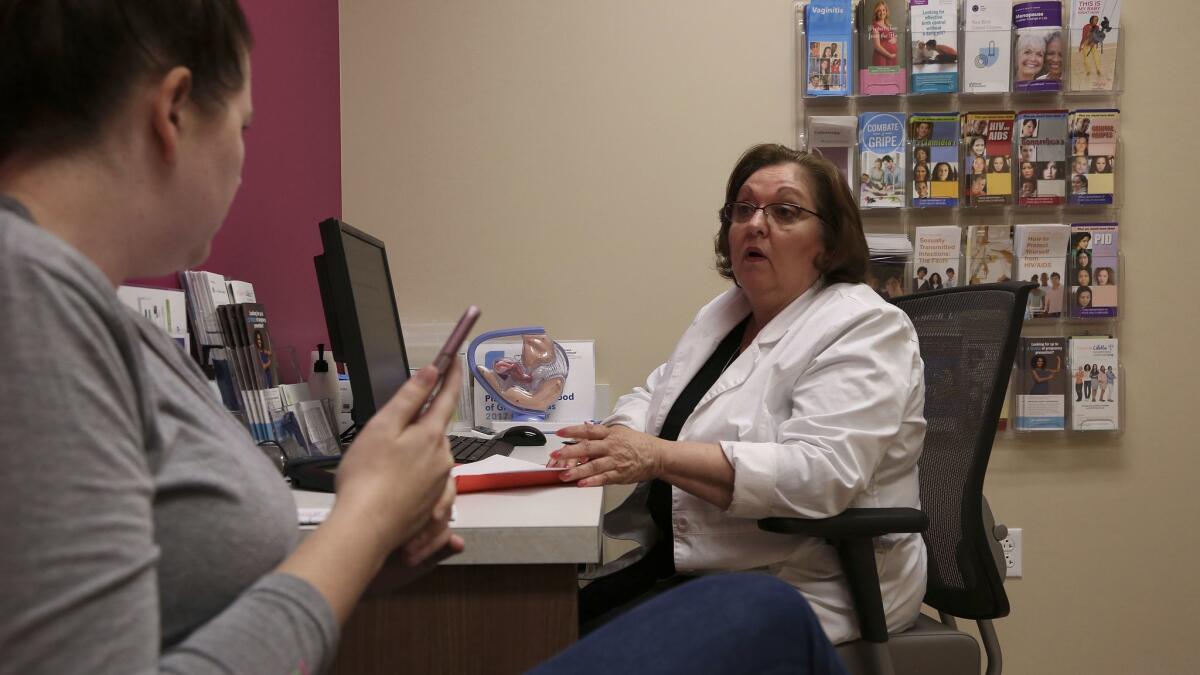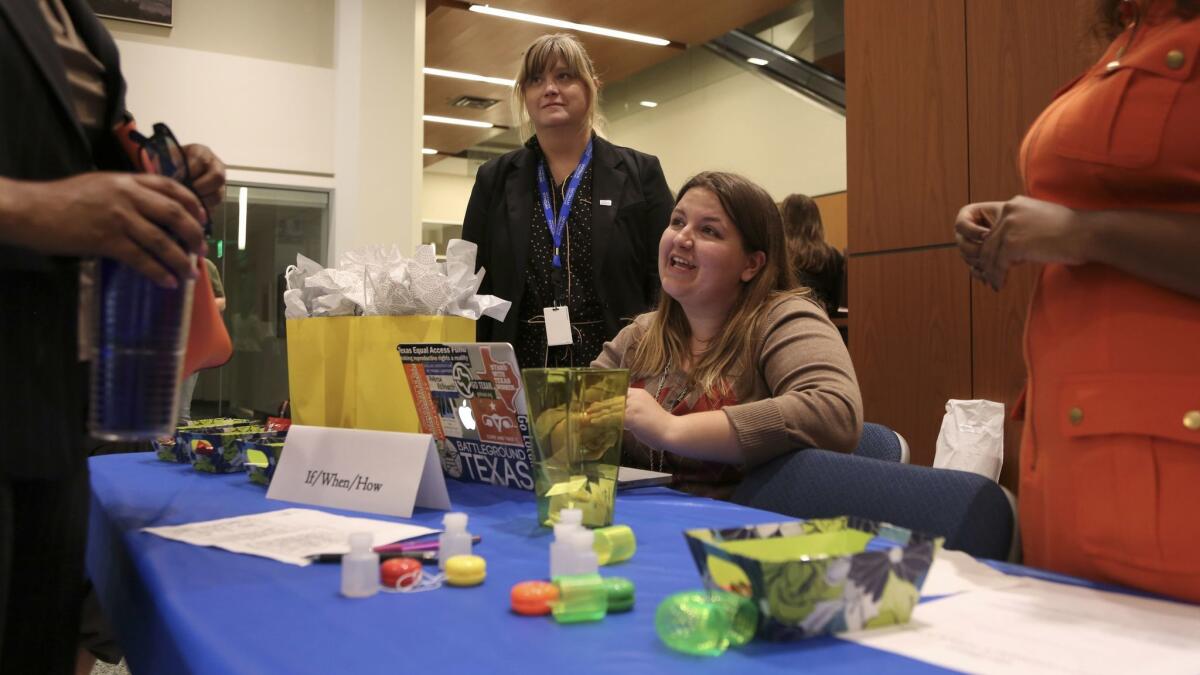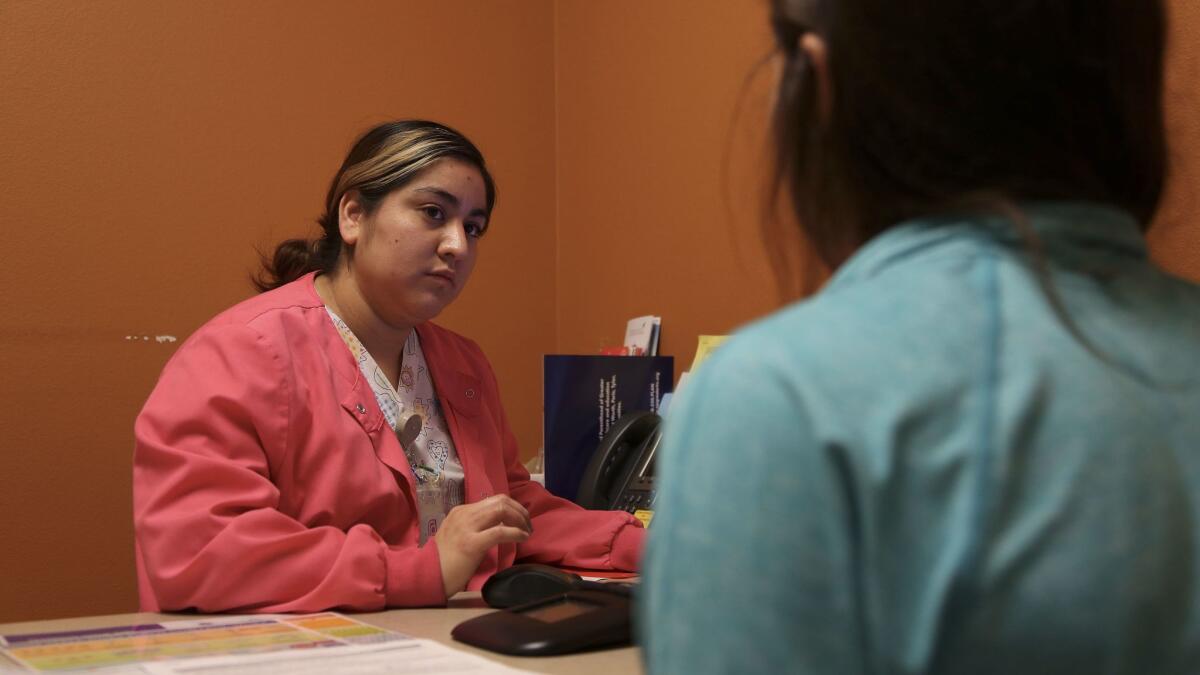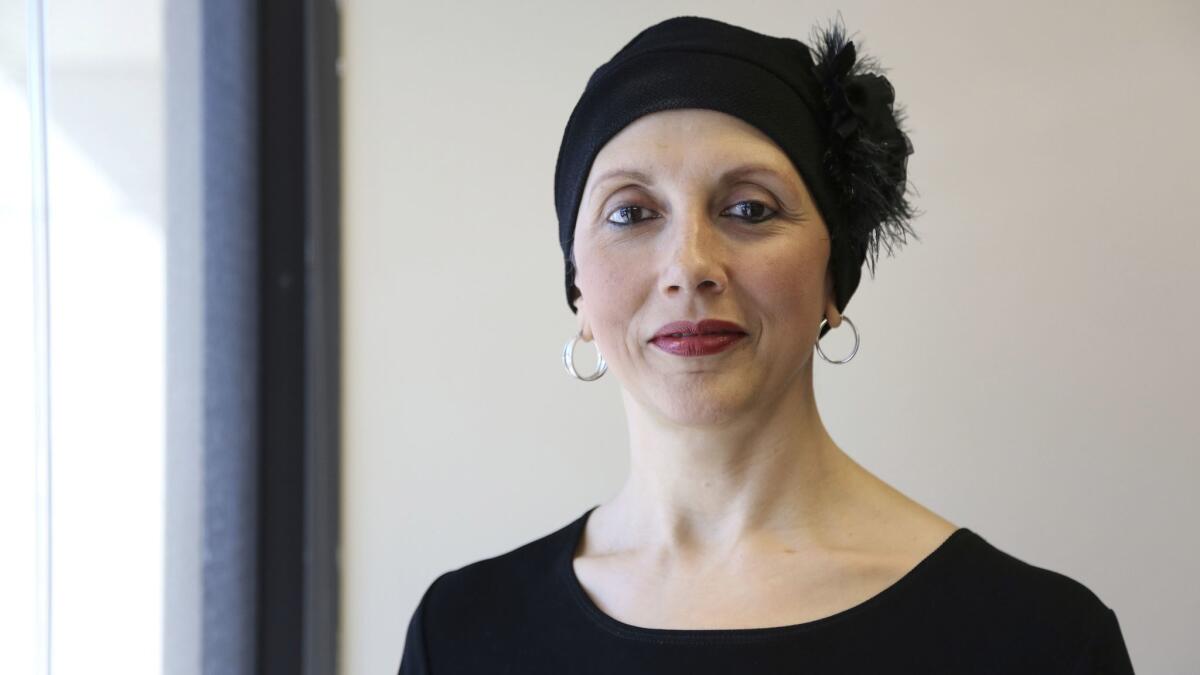‘Defund Planned Parenthood’ has gained momentum. Texas shows how extensive the effects can be

It was Aubrey Reinhardt’s last year at university. So when things started getting serious with her boyfriend, she decided to find out about birth control options. That’s when things got complicated.
- Share via
Reporting from Dallas — It was Aubrey Reinhardt’s last year at Texas Tech University. So when things started getting serious with her boyfriend, she decided it was time to look into birth control.
Reinhardt knew that abortion foes had been trying to strip Planned Parenthood of every penny it receives from government sources. But until that moment two years ago, Reinhardt recalled, she didn’t appreciate what that could mean for a person like her who just needed somewhere to go for affordable contraception — without feeling she was being judged.
Planned Parenthood had to close its two health centers in Lubbock, where Reinhardt was studying, so she turned to the campus clinic. But the doctor there told her she might have a blood clotting problem, and said Reinhardt would need to get approvals from three other doctors and a hormone specialist before she would prescribe contraception.
Reinhardt, now a 22-year-old law student in Dallas, was stunned. None of her previous physicians had suggested she might have such a problem. Could the doctor be using it as an excuse? She could feel herself tearing up.
“Why are you crying?” she recalled the doctor asking. “Are you really in that big of a hurry to become sexually active?”
Humiliated, Reinhardt hurried out of the office.

In the annals of the abortion wars, the call to “defund Planned Parenthood” has become one of the most potent — and contentious — rallying cries. The organization is the largest single provider of abortions in the country and has used its political clout to protect access to the procedure.
Now with President Trump in the White House and Republicans in control of Congress and statehouses across the nation, those seeking to curtail public funding for Planned Parenthood see opportunities to achieve their long-sought goal — and they see Texas as a model to follow. But as Reinhardt’s experience shows, the effects of a successful defunding campaign can be far more extensive — and potentially damaging — than intended.
In 2011, Texas lawmakers slashed funding for family planning clinics rather than allow any of the money to go to Planned Parenthood. Because of the cuts, a quarter of the state’s clinics closed, making it harder for women of limited means to get a range of other basic health services, including contraception, breast and cervical cancer screenings, and testing for sexually transmitted infections.
Lawmakers have since attempted to repair the damage by directing more money to facilities not tied to abortion providers. But there isn’t always a facility that can readily fill the void when women are denied access to Planned Parenthood, which serves about 2.4 million patients nationally each year.
Federally funded community health centers, which provide a range of low-cost primary care to poor families, are stretched thin. And family planning is not routinely offered at 40% of these facilities, according to a study by the Guttmacher Institute, which advocates for reproductive rights, including abortion.

After Reinhardt’s upsetting visit to the campus clinic, she called one such center in Lubbock. The soonest she could get an appointment was in April. It was January. She then tried facilities operated by Christian nonprofits. They didn’t offer contraception.
So she called what was left of Planned Parenthood. They could see her right away, but their nearest locations were in El Paso and Fort Worth, both four-hour drives away.
Over spring vacation, Reinhardt drove to Fort Worth and received an implant that prevents pregnancies for up to four years. But she wondered, “What about the mother that has two children, that works two jobs, that can’t take off two days to drive four hours away to a clinic and come back?”
It is already illegal to use federal dollars for abortions, except in cases of rape, incest or when the mother’s life is in danger. And Planned Parenthood says about half of its health centers don’t offer the procedure.
But the group’s opponents argue that giving Planned Parenthood public funds for non-abortion-related care allows it to spend more of its private funds on abortions. In 2016, the group received $554.6 million from government sources, about 40% of its budget.
The Republican bill to replace Obamacare, which narrowly cleared the House on May 4, would prevent Planned Parenthood from receiving reimbursements from Medicaid for a year.
That would be a big hit. Medicaid, the federal-state program that insures more than 70 million poor Americans, accounts for the majority of Planned Parenthood’s public funding, according to Congressional Budget Office estimates. Federal Title X family planning grants make up most of the rest.
The House bill, the American Health Care Act, faces an uncertain future in the Senate. And states have faced pushback from federal officials and the courts when they try to withhold federal money from Planned Parenthood themselves.
Texas, however, has found roundabout ways to chip away at the group’s funding.
Texas Republicans scored their first big win in 2011 when the Legislature reduced the two-year budget for the state’s Family Planning Program to $38 million from $111 million. It also approved a new way to allocate the funds that prioritized community health centers and county health departments over specialized family planning clinics like those affiliated with Planned Parenthood.
The argument was that women would be better served if they had their reproductive health needs addressed at facilities that could provide more comprehensive care; critics contend it was a way to squeeze out Planned Parenthood.
Texas also wanted to exclude Planned Parenthood from a separate Medicaid-funded program that offered family planning coverage for certain women who didn’t qualify for full healthcare benefits. But the Obama administration wouldn’t allow that because of a federal law guaranteeing Medicaid clients their choice of providers.
The Legislature’s solution: Forgo federal funding that had paid for 90% of the program and set up an entirely state-financed version called the Texas Women’s Health Program. That effort, launched in 2013, does not contract with clinics affiliated with abortion providers.

Texas’ actions have provided a road map for other states to follow. In May, Planned Parenthood announced it was closing four of its 12 clinics in Iowa after lawmakers there decided to set up a state-run family planning program that can legally exclude the group.
Planned Parenthood wasn’t the only organization hurt by such decisions. By 2013, 82 Texas clinics — a third of them Planned Parenthood affiliates — had closed or stopped offering family planning services, said Kari White of the Texas Policy Evaluation Project, which studied the defunding effort. None of the clinics performed abortions.
Of those that remained open, researchers found, many had to reduce hours or begin charging for services previously offered for free.
Even when there were other clinics nearby where women could use their state benefits, White said, women would often find that they did not stock the more expensive, long-acting birth control methods available at Planned Parenthood. So women switched to less effective methods, and a few years later, some had become pregnant.

State officials take issue with some of the conclusions because they are based on a study that sampled only patients enrolled in the Texas Women’s Health Program — expanded and rebranded last year as Healthy Texas Women — and not those who received family planning care through other programs.
Now that Trump is in the White House, the state is applying to get its Medicaid funding back for Healthy Texas Women. Since 2013, the Legislature has also committed more than $150 million in additional state funds to rebuilding the network of family planning providers and improving care for poor women — more than making up for the clinic closures, according to officials.
Although participation in the state’s women’s health programs plunged from around 359,000 in 2011 to 201,000 two years later, state figures show, the number of clients enrolled has increased since then and in 2015 was approaching 364,000.
“Texas is committed to women’s health,” Republican state Sen. Jane Nelson, who heads the Senate Finance Committee, said in an email. “The number of providers has tripled, and we are making sure that women throughout the state can access these vital services.”
Kelly Hart, a spokeswoman for Planned Parenthood of Greater Texas, acknowledged the state’s efforts to improve family planning. But she said a question lingers: “Can [those efforts] be as good as the citizens of this state deserve if you deny a major player in women’s healthcare a seat in your program?”
Planned Parenthood has 34 health centers left in Texas, four of which perform abortions.

Community health centers will try to fill the gap, but many will need to hire and train staff, reconfigure space and purchase equipment, said Jose Camacho, who heads an association of such facilities in Texas.
In the meantime, women who rely on publicly funded healthcare are still having trouble finding providers who will accept new patients and can see them in a timely manner, Planned Parenthood clinicians say. That can be critical for some patients.
Four years ago, Dayna Farris-Fisher, a mother of three from Plano, discovered a lump in her breast. She didn’t have insurance, because her husband had been laid off. None of the low-cost clinics she tried could see her for at least four months.
In a panic, she called Planned Parenthood. Vivian Bigelow, a nurse practitioner at the group’s local health center, saw her the next day.
But if a patient like Farris-Fisher, now 50, walked into her exam room today, Bigelow said, she would have to refer her somewhere else. The breast and cervical cancer screening program that paid for the diagnostic testing no longer accepts claims from Planned Parenthood, another casualty of the state’s defunding efforts.
That terrifies Farris-Fisher. In the five weeks that it took to confirm a diagnosis and begin treatment, her tumor doubled in size.
“If I had had to wait for one of those other clinics,” she said, “I literally am convinced that I would be dead.”
Twitter: @alexzavis
ALSO
The Church of Scientology wanted a vacant lot. So did the city of Clearwater, Fla. One of them won
Even with Irvine’s diverse mix of cultures, some residents feel they don’t ‘fit’
More to Read
Sign up for Essential California
The most important California stories and recommendations in your inbox every morning.
You may occasionally receive promotional content from the Los Angeles Times.











